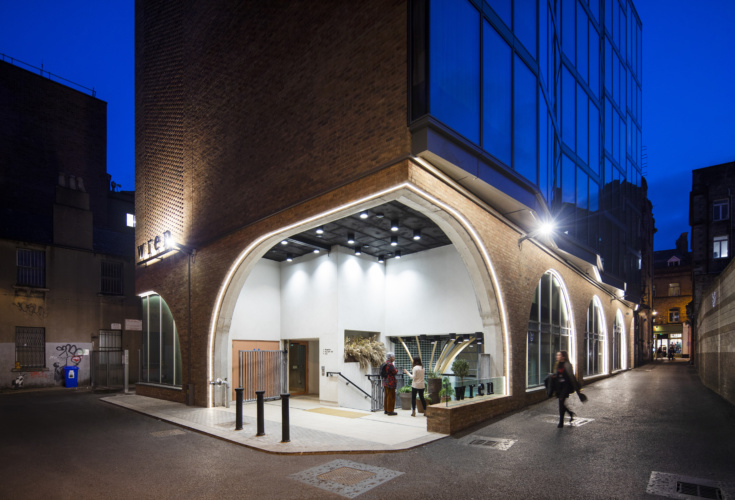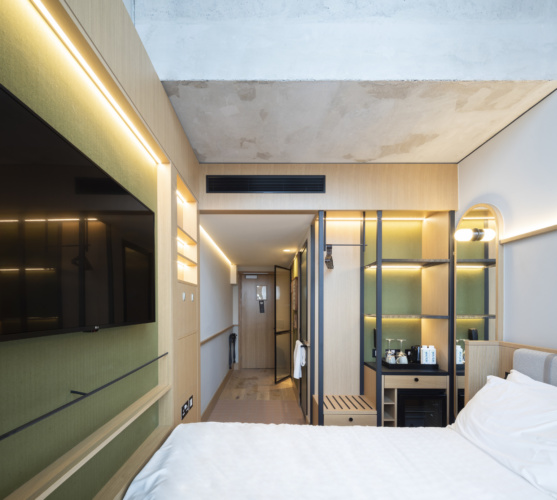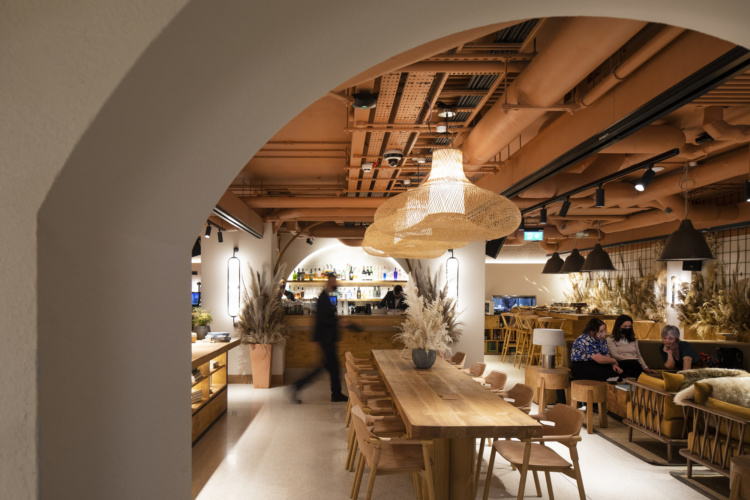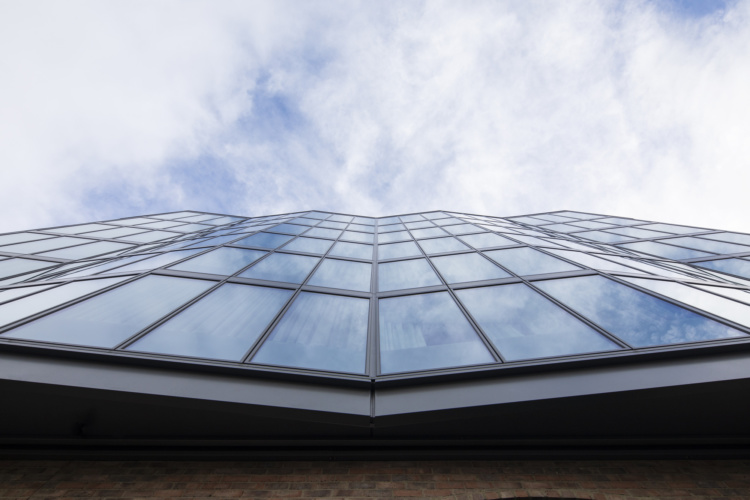
As hotels go, Dublin’s Wren Urban Nest cuts a relatively unassuming figure. Tucked discretely in a quiet enclave of the Irish capital’s bustling city centre, the 137-room, nine-floor structure could almost pass for a sleek new office building or hotdesking space. Indeed, the subterranean Scandi-influenced bar/café could be lifted straight from a WeWork brochure.
While there is certainly no shortage of understated style on display, The Engineer is visiting to find out about the substance, for the Wren is the subject of some interesting claims. Chief of these is that it is (or will be, when annual numbers are run) Europe’s most sustainable city centre hotel. It is also claimed to be ‘net zero operational carbon’, whereby all the building’s day-to-day energy needs are met with renewables and without the workaround of carbon offsets.
The first feasibility study of the site began in 2016 when it was still home to Andrew’s Lane Theatre, a two-storey building that staged works by Roddy Doyle and Maeve Binchy down through the years. Alongside objections from Dublin’s arts community, the initial proposals also faced planning hurdles due to the compact and enclosed location.

“Essentially, the site itself is absolutely tiny, there’s constraints all around it,” explained Patrick Kavanagh, engineering associate at BDP, the multidisciplinary practice that led the Wren’s architectural and engineering development. “On the east facade, those buildings are of a conservation nature. So you have to kind of step back from them and allow a certain distance from them.”
Given those constraints and the legal requirements for daylight and space in apartments, a boutique hotel became the obvious choice for the site. Compared with an average hotel room size of 22m2, the Wren’s rooms come in between 10 and 12m2. According to Kavanagh, maximising the number of snug units was one of the first steps towards making the project sustainable, both commercially and environmentally.
“From a sustainability perspective, one of the things that we were kind of pushing at the time - and it’s now becoming a lot more topical - was this idea of whole life embodied carbon,” he said.
“The embodied carbon you use to build a building - how sustainable it is can also be a function of how much use you get out of it. So by packing more bedrooms, increasing the occupancy density of the building, it essentially reduces the carbon footprint per key, per room. So per room the embodied carbon of this building is actually about 50 per cent of what a typical hotel is.”
In terms of producing its own energy, the Wren’s small footprint, central location and proximity to neighbours limited the potential for on-site renewables, which at best could have delivered around 10 per cent of the building’s requirements. Rather than installing a token amount of solar PV, BDP instead concentrated on energy use, with specific attention on HVAC and hot water, both of which drive huge energy demand in hotels.
“Obviously, a lot of people have showers and then because it’s overnight accommodation, there’s either fresh air being heated which is being provided to the building, or there’s heat loss that needs to be put back in,” said Kavanagh.
“So instead of focusing on just slapping on a small amount of photovoltaics for good measure to tick a kind of green box, we thought let’s not focus on that. Let’s focus on how we can improve the heating and hot water.”

Instead of solar panels, a large section of the roof is dedicated to two large air source heat pumps which manage both the cooling and heating loads for the Wren’s guest rooms and communal spaces. Hot showers are driven primarily by water-to-water heat pumps, with both systems working in tandem, excess heat from glazed facades and other parts of the building topping up the hot water supply when possible.
“When the building is operating in its peak energy mode is when there’s a heating and cooling load,” Kavanagh explained. “So essentially the west facade here is glazed facade and in the afternoon the sun is going to hit that facade, and so there’s always going to be a cooling load. If you imagine these 12.5 square metre rooms, the sun is hitting that window, it’s going to need some cooling, even in winter. So it’s always then topping up that hot water.”
When I visit, the building has only been open for a few months, but the data so far is encouraging, according to BDP. After a full 12 months, a more complete picture should emerge and the Wren can see if its claims as Europe’s most energy efficient hotel really stack up.
“At the moment, it’s essentially running where over 60 per cent of the time, the heating is free,” said Kavanagh. “In the summer months, there’ll be a higher cooling load, so more heat being put into the hot water. If anything, we could end up with 100 per cent of the hot water being offset.”
The hotel also has no air recirculation between rooms - reassuring in the time of COVID but potentially a nightmare for energy loss - with used, heated air constantly pumped out and incoming clean air demanding constant heating. A solution was found in the form of a thermal wheel in the plant room on the Wren’s top floor, a large, slowly moving mass of metal that extracts the heat from discarded hotel air and transfers it to the cooler, fresh air being pulled in.
“As the hot plate comes down to the cold air stream, it essentially pre-heats air that’s coming in,” said Kavanagh. “It’s 81.3 per cent efficient, which basically means that, to keep it very simple, if the air going out is 10 degrees higher than the air coming in, then the air coming in will be preheated by 8 degrees.”
“The idea is just constantly trying to capture heat. When somebody’s showering, there’s heat off that, there’s water, there’s condensation. That’s all going into the system and that all gets captured, that heat, and put back into the airstream.”

This philosophy permeates through the entire hotel, small design touches all adding up and working in harmony to balance heating loads and minimise energy use. Heat gain from the glazing can be toned down by automatically closing blinds in rooms where guests aren’t present. Exposed concrete slabs that overhang the bedrooms serve not only as a minimalist design flourish, but also as a thermal mass to absorb excess heat during the day and release it back at night, reducing peak cooling and heating loads.
Form and function also come together on the hotel’s west facade. Cleverly angled glazing creates a curtain-like effect designed to both catch the eye and reduce the sun’s impact in the afternoon, a time when most guests are checking in and energy use ramps up. In the Wren’s kitchen, induction hobs allow the building to operate entirely without gas, eliminating local pollution and allowing the hotel to run on 100 per cent renewables. Unused food from the kitchen is redistributed via the ‘Too Good to Go’ app, while throughout the building, water points encourage guests to refill their own bottles.
It all adds up to a pretty convincing package, ‘luxury without the guilt’, according to the marketing schtick. Whether the Wren can officially be called Europe’s most sustainable hotel remains to be seen, but for now it is laying claim to the Irish title at least. A small hotel with big ideas, hoping its green credentials help it stand out from the flock.




April 1886: the Brunkebergs tunnel
First ever example of a ground source heat pump?